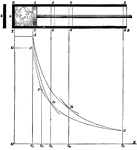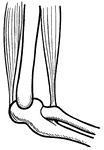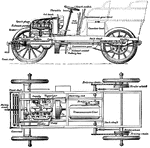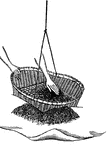
Linear Expansion
Linear expansion is elongation (of an iron bar) in one direction. A is a metal rod, B is a screw, C…

Outer Work
Example of outer work. Outer work is the overcoming of the outside pressure through a certain distance…

Isothermal Expansion
Isothermal expansion is a change in a system with a constant temperature. This occurs when: A. Said…
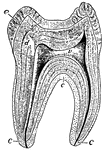
Human Tooth
A sectional view of a human molar. The roots, or fangs, are shown covered by a layer of bone called…

Human Esophagus
An Image of an esophagus showing how a mass of food, or bolus, passes through the esophagus into the…
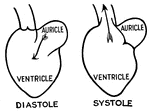
Heart Cycle
The cycle of the heart in its diastole (relaxation) state and its systole (contraction) state. The ventricles…
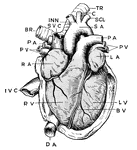
Anatomy of Heart
A complex anatomical view of the heart. RA is the right atrium, or auricle, which receives the deoxygenated…
Striated Muscle
Striped, or striated, muscle which quickly contracts causing the alternating black and white lines.…
Smooth Muscle
Three sections of smooth muscle. M C is muscle cells and N is nucleus. Smooth muscles are slow to contract.…
Nerve Cell
A simple nerve cell, or neuron. N is the nucleus of the cell, NC is the cytoplasm, D are dendrites which…
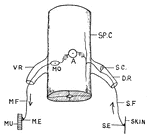
Reflex Action
Illustration of the reflex action of an animal. SE is the sensory nerve-ending. A stimulus passes through…
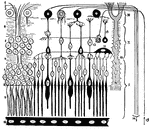
Eye Retina
Diagram of the retina, aka percipient layer of the eye. 1: inner limiting membrane, which is next to…
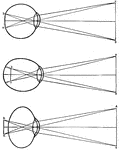
Human Eye
Diagrams of how an image is displayed with a normal eye (top image), myopic or nearsighted eye (middle…
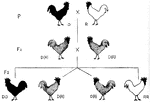
Genetics Chart
Mendelian chart for chickens. P is parent with black dominant and white recessive, F1 is the hybrid…
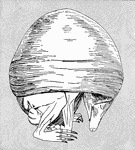
Skinned Hedgehog
A skinned hedgehog. This image is supposed to show the muscles of the back which contract to make the…

Hancock Coaches
A Hancock Coach cross-sectioned in order to display the engine and driving connections. (A) is the exhaust…

Notable Coach
The Notable Coach, Invented around 1829 by a man named James. It was the first practical steam carriage…

Old-Fashioned Wheel
An image of an old-fashioned wheel. It was most likely used on a steam coach or carriage in the nineteenth…
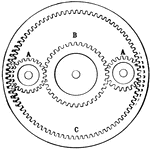
Differential Gear
A form of gears that used to be employed for tricycles. The studs (AA) are set into the sprockets and…

Gear Differentials
Gears used in an older model car. The sprocket gear (far left) carries three bevel pinions on its three…

Balance Gear
As its name entails, this gear is useful at balancing out automobiles. This gear was employed often…

Joint Differential
A universal joint differential. The sprocket is used to twist the sleeve that is holding the gear in…
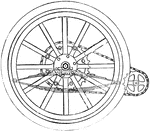
Power Transmission
A wheel of a car fitted with a double-chain drive from a jack-shaft that is parallel to the rear axis.

Wheel Position
The manner in which the wheels of a railway car orient themselves around a curve. The outer and inner…

Steering Device
A Worm and sector steering device, cross-sectioned. It was developed by Panhard-Levassor. The spindle…

Steering Devices
Two types of steering devices. The image on the left is a combined nut and rack steering gear. It is…
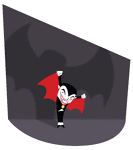
Vampire
A cartoon of a Vampire as depicted in the classic black and white monster movies of the first half of…
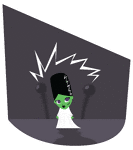
Bride of Frankenstein
A cartoon of the Bride of Frankenstein as depicted in the classic black and white monster movies of…

Wolfman
A cartoon of the Wolfman as depicted in the classic black and white monster movies of the first half…

Mummy
A cartoon of the Mummy as depicted in the classic black and white monster movies of the first half of…
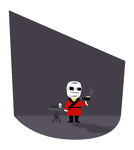
Invisible Man
A cartoon of the Invisible Man as depicted in the classic black and white monster movies of the first…
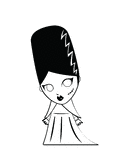
Bride of Frankenstein (Black and White)
A simple black and white line art cartoon of the Bride of Frankenstein depicted in the classic black…
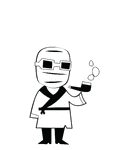
Invisible Man (Black and White)
A simple black and white line art cartoon of the Invisible Man depicted in the classic black and white…
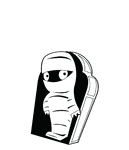
Mummy (Black and White)
A simple black and white line art cartoon of the Mummy depicted in the classic black and white monster…
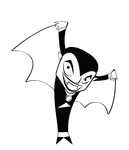
Vampire (Black and White)
A simple black and white line art cartoon of a Vampire depicted in the classic black and white monster…
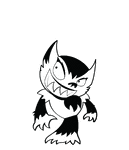
Wolfman (Black and White)
A simple black and white line art cartoon of the Wolfman depicted in the classic black and white monster…

Trick-R-Treaters (Black and White)
A black and white line art version of a brother (the spaceman) and his friend (the dinosaur) taking…

The New Guy (Black and White)
A black and white line art version of the Mummy, Frankenstein's Monster, and a zombie discuss things…
Nina, Pinta, and Santa Maria (Black and White)
A simple black and white illustration of Christopher Columbus' ships at sea. Illustrated by James Basom…
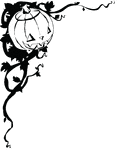
Jack-O-Lantern Corner (Black and White)
A black and white decorative border for Halloween featuring a jolly Jack-O-Lantern. Illustrated by James…
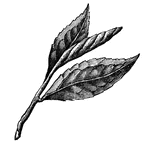
Three tea leaves
Three Chinese tea leaves. In some Chinese tea making processes, only the first three leaves were picked.

Plucked Tea Leaves (Six)
Unlike Chinese tea making methods (which involve plucking only three leaves), Indian methods are shown…

Drying Tea Leaves
Tea leaves are placed in the basket atop the oven and receive a steam bath, drying them out.

Leaves in Furnace
Five pounds of tea leaves are taken out of the steam bath and put in a stone furnace.

Gridiron support (Tea Making)
A wooden tray designed to encase a gridiron support, which in turn holds tea leaves heated in the furnace.

Sorting Leaves
The tea leaves are taken to long, low tables where the stems and uncurled leaves are separated and discarded.

Tea Balls
The tea leaves are steamed until they reach a desirable fragrance. They are then rolled or kneaded by…
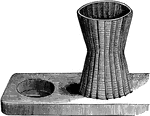
Cylindrical Basket
The tea sieves are placed in a cylindrical basket that is slightly contracted in the middle.

Drying and Rolling Tablet
Tea leaves can be dried in sunlight and rolled by means of a channeled stone tablet with hollow sides…

Tea Drying in Baskets
Tea leaves are placed in tiered, horizontally arranged baskets. The floor has a channel running its…
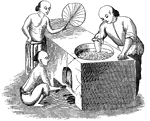
Tea Leaf Treatment
A kuo basket is placed above a furnace to be hand-stirred by a worker in order to regulate the leaf…
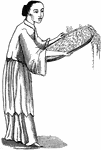
Winnowing Tea Leaves
Tea leaves are passed through sieves then winnowed via tossing on large bamboo trays.
